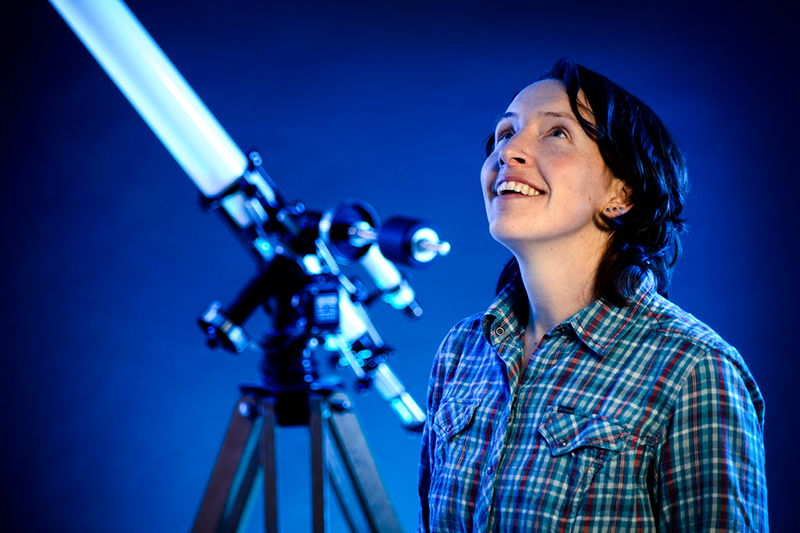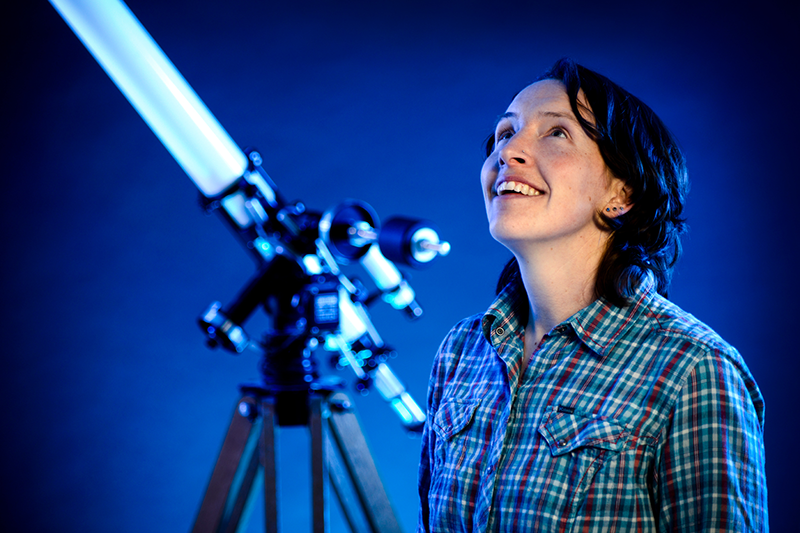An Astronomer’s Appeal for Satellite Regulation
In 2019 astronomer Samantha Lawler moved from the Canadian province of British Columbia to that of Saskatchewan to take up a position at the University of Regina. There, she expected to be fully engrossed in studying the early movements of our Solar System’s giant planets. But after spending time gazing up at the Milky Way from her own backyard—something she was able to do now that she lived in an area with minimal light pollution—she started down a second, all-consuming path: advocating for satellite regulation.
Lawler was spurred into action after noticing that the images she was capturing of the night sky were being streaked by light reflected from the lengthening train of satellites that were crossing her field of view. “It was a selfish concern at first,” she says. But the concern soon became broader when she realized the potential impact of these streaks on astronomy research data beyond her own. Physics Magazine caught up with Lawler to learn more about the problem and to find out why she has made it her mission to educate the public about the impact of satellites on telescope data.
All interviews are edited for brevity and clarity.
When did satellite constellations start to become a noticeable problem for astronomers?
When SpaceX started launching Starlink internet satellites. These satellites are bigger than most other communications satellites, and they operate at lower orbital altitudes, so they appear much brighter in images taken from the ground. Today Starlink satellites make up 62% of all satellites orbiting Earth.
How exactly do the satellites show up in observations?
As bright streaks of light across the data. I study objects called trans-Neptunian objects, or TNOs, which are objects that are farther from the Sun than Neptune. For that, I need to understand all the biases that go into observations of these icy systems, which include dwarf planets and some comets. The satellite streaks are changing those biases, causing problems for the detection methods we currently use.
How bad is the problem?
Big: we think it will compromise the results of an upcoming survey that aims to find more TNOs, as the signals of TNOs are millions of times fainter than those of satellites.
We detect TNOs by tracking the motion of objects across the sky over the course of hours, months, and years. When a Starlink satellite passes across a telescope’s field of view as the telescope is taking data, the reflections from the satellite compromise the information in all the pixels the satellite shows up in, as well as in some of the neighboring pixels. That compromization can cause us to lose sight of an object, making it harder for us to determine what the object is. It can also make any motion measurements of known TNOs less accurate.
Is there anything researchers can do to mitigate this problem?
We are working on it: three people I work with are trying to remove satellite streaks from our data in a minimally invasive way, but doing so always adds some noise and changes our biases. The best current method we have behaves like a chemotherapy drug: it’s violent and can wipe out much more information than we want it to.
Also, these team members could be working on actual science—analyzing the data and interpreting what it tells us—rather than spending hours trying to filter out satellites. Having to do that is making our taxpayer-funded science less efficient.
Is there an alternative solution?
Yes, governments and companies should make satellites less bright. There also needs to be an internationally agreed limit on how many satellites orbit Earth. There are now 10,000 satellites circling the globe. That’s too many.
Some work is happening to limit satellite brightness. Starlink engineers have reduced the reflectivity of their more recently launched satellites, for example. But they’ve also made the satellites bigger, so the overall level of the problem hasn’t really changed. The US Federal Communications Commission also just approved new “Direct-to-Cell” Starlink satellites, which aim to provide even wider access to cell phone and internet services and will lead to more and bigger satellites being launched.
Astronomers predict that the light reflected from these new satellites will be so intense that people will be able to see them from huge cities with high levels of light pollution, such as Toronto. That intensity level could ruin observations at facilities such as the Vera C. Rubin Observatory in Chile, which is expected to come online next year. The cellular broadband company AST SpaceMobile also just launched its first satellite, which has the same brightness in optical telescope images as the brightest stars in the sky. So it’s a rapidly escalating problem.
How can concerned citizens and scientists help?
Write letters to your elected officials advocating for better ground-based rural internet access so that huge satellite constellations such as Starlink are not needed. Publish opinions on the need for satellite regulation. Get involved with groups already fighting for that regulation, which include DarkSky International, the American Astronomical Society’s light pollution committee COMPASSE, and the International Astronomical Union’s Centre for the Protection of the Dark and Quiet Sky from Satellite Constellation Interference. Everyone who looks up at the night sky needs to make their voice heard.
More Information
Opinion: Stand Up for Satellite Regulation by Daniel Baker, University of Colorado, Boulder.
–Rachel Berkowitz
Rachel Berkowitz is a Corresponding Editor for Physics Magazine based in Vancouver, Canada.





